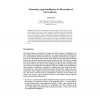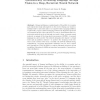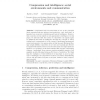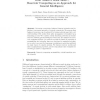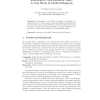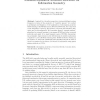122
Voted
AGI
2011
14 years 4 months ago
2011
Under Legg’s and Hutter’s formal measure [1], performance in easy environments counts more toward an agent’s intelligence than does performance in difficult environments. An ...
122
click to vote
AGI
2011
14 years 4 months ago
2011
Human intelligence consists largely of the ability to recognize and exploit structural systematicity in the world, relating our senses simultaneously to each other and to our cogni...
86
Voted
AGI
2011
14 years 4 months ago
2011
Compression has been advocated as one of the principles which pervades inductive inference and prediction - and, from there, it has also been recurrent in definitions and tests of...
106
click to vote
AGI
2011
14 years 4 months ago
2011
We present an architectural approach to learning problem solving skills from demonstration, using internal models to represent problem-solving operational knowledge. Internal forwa...
115
Voted
AGI
2011
14 years 4 months ago
2011
Abstract. Recurrent connectivity, balanced between excitation and inhibition, is a general principle of cortical connectivity. We propose that balanced recurrence can be achieved b...
115
Voted
AGI
2011
14 years 4 months ago
2011
Abstract. This paper considers the consequences of endowing an intelligent agent with the ability to modify its own code. The intelligent agent is patterned closely after AIXI with...
116
click to vote
AGI
2011
14 years 4 months ago
2011
Abstract. A novel approach to create a general vision system is presented. The proposed method is based on a visual grammar representation which is transformed to a Bayesian networ...
118
click to vote
AGI
2011
14 years 4 months ago
2011
Abstract. Humans have the remarkable ability to generalize from binocular to monocular figure-ground segmentation of complex scenes. This is clearly evident anytime we look at a p...
108
Voted
AGI
2011
14 years 4 months ago
2011
Abstract. Non-Axiomatic Logic (NAL) is designed for intelligent reasoning, and can be used in a system that has insufficient knowledge and resources with respect to the problems to...
139
Voted
AGI
2011
14 years 4 months ago
2011
Inspired by a broader perspective viewing intelligent system dynamics in terms of the geometry of “cognitive spaces,” we conduct a preliminary investigation of the application ...
